Physical Address
304 North Cardinal St.
Dorchester Center, MA 02124
Physical Address
304 North Cardinal St.
Dorchester Center, MA 02124

Osteoarthritis is a chronic condition that affects millions of people worldwide, leading to pain, stiffness, and diminished quality of life. As the most common form of arthritis, it occurs when the protective cartilage that cushions the joints wears down over time. Managing osteoarthritis requires a multi-faceted approach that goes beyond conventional treatments.
By exploring the connections between diet and joint health, implementing effective weight management for arthritis, and considering alternative therapies for arthritis, individuals can take proactive steps toward alleviating symptoms and enhancing their overall well-being. In this guide, we will delve into practical strategies and lifestyle adjustments that can empower those living with osteoarthritis to reclaim their mobility and comfort.
As we get older, our joints can wear down and hurt, making simple tasks hard. For those with osteoarthritis, finding ways to ease pain and keep joints healthy is key. This guide will help you manage osteoarthritis, so you can stay active and enjoy life.

Managing osteoarthritis involves using both non-drug and drug treatments. Losing weight is crucial, especially for knee osteoarthritis1. A 5% weight loss in 20 weeks can help knee osteoarthritis, and losing 10% can improve symptoms by up to 50%1. Exercise, both on land and in water, is also vital for managing the condition.
For drug treatments, NSAIDs are often the first choice for osteoarthritis1. They work as well as, or better than, paracetamol1. But, NSAIDs can cause stomach problems, leading to over 16,500 deaths and hospitalizations in the USA each year1. Taking a proton pump inhibitor with an NSAID can lower stomach pain by 66%1. Paracetamol is no longer the first choice due to its limited pain relief and risks when used too much1.
Self-management programs can help you understand and manage osteoarthritis2. These programs are available online and in-person. Cognitive-behavioral therapy can also improve your pain, mood, and function2. Acupuncture and radiofrequency ablation are other options for long-term pain relief2.
Osteoarthritis is a common joint condition that affects millions worldwide. In the United States, over 32.5 million adults suffer from it3. It mainly affects hands, knees, hips, and spine joints4. This disease causes cartilage loss, bone growths, and joint damage.
Osteoarthritis slowly gets worse over time4. It happens when cartilage wears down, leading to pain and stiffness. This can make everyday tasks hard4.
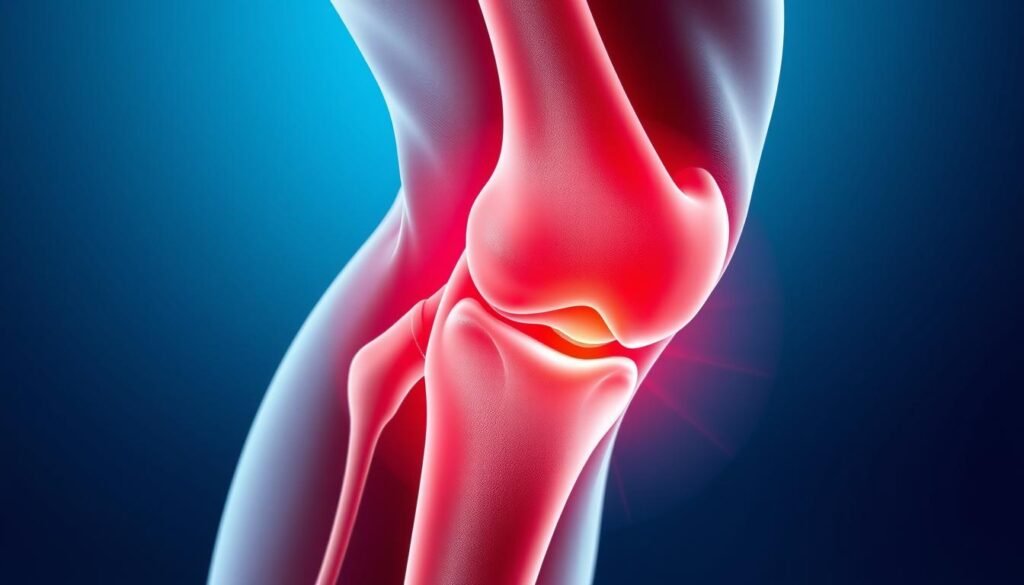
Many things can lead to osteoarthritis, like age and obesity4. Women are more likely to get it than men34. Being overweight puts extra stress on joints, raising the risk4. Past injuries and family history also play a role3.
Symptoms often show up in people over 50, but can happen younger3. A doctor will check for tenderness and swelling during an exam. X-rays and MRI help diagnose it. Blood tests and joint fluid analysis rule out other causes.
Research shows that people with osteoarthritis may have up to 30% more falls and a 20% greater risk of fracture compared to those without the condition.
Seeing a doctor is key if you have ongoing joint pain or stiffness. Early treatment can help manage symptoms and slow the disease’s progress.
Managing mild to moderate knee osteoarthritis (KOA) without drugs is key. In India, KOA affects 17% to 61% of people. Experts agree that exercises are best for mild KOA, and all agree for moderate KOA5. Physical activity helps with pain, stiffness, and function in osteoarthritis patients6.
Guidelines suggest 150 minutes of moderate activity and two strength training sessions weekly6. Even 45 minutes of activity a week can help with function in lower extremity osteoarthritis6. It’s important to do exercises that keep cartilage healthy and make daily activities easier6.
Aquatic exercises are more popular and satisfying than land-based ones6. Strength training with resistance can also reduce pain and improve function in knee and hip osteoarthritis6.
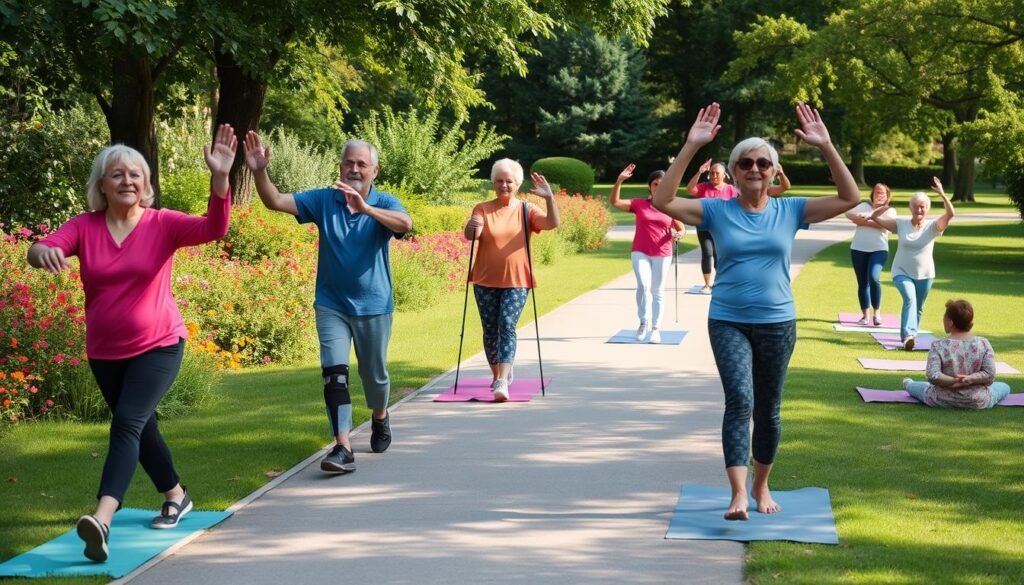
Being overweight is a big risk factor for osteoarthritis. Losing 5-10% of body weight can greatly improve symptoms. The Framingham Study shows that weight loss can lower the risk of knee osteoarthritis in women7.
Using canes, knee braces, and foot orthoses can help with pain and function. Non-pharmacological treatments for KOA include exercises, weight loss, and more5.
| Expert Group | Recommendation of Deep Relaxation/Meditation for KOA |
|---|---|
| Orthopaedists | 95% |
| Physical Medicine Rehabilitation (PMR) Specialists | 90% |
| Physiotherapists | 75% |
Despite the benefits, experts don’t fully agree on the best non-drug treatments for KOA5.
When non-pharmacological methods don’t work, medications can help manage osteoarthritis pain. Over-the-counter pain relievers like acetaminophen can ease mild to moderate pain8. But, it’s important to use acetaminophen carefully because of overdose risks and liver damage9.
NSAIDs, like ibuprofen, are also used for pain relief. They work well but might have side effects8. Oral NSAIDs are good for pain but better for inflammation in hands, knees, and hips9.
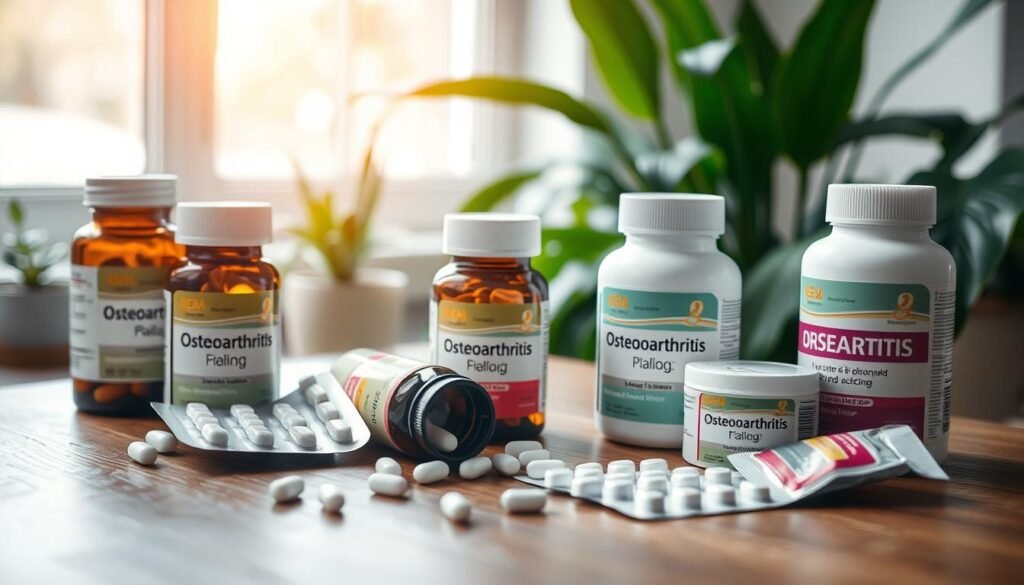
Topical NSAIDs are FDA-approved for hand, hip, and knee OA. They have less systemic absorption and are better tolerated by some patients9.
For severe pain, prescription drugs might be needed. Duloxetine is approved for chronic pain and osteoarthritis8. It can reduce pain but may cause nausea, constipation, fatigue, and sleepiness, especially in older adults9.
Opioids, like tramadol, are used for severe OA but with caution. They can lead to dependence, breathing problems, and even death9. A study found similar pain relief from NSAIDs, weak opioids, and strong opioids. But, opioids have more side effects, making careful consideration important9.
| Medication | Recommended Use | Potential Side Effects |
|---|---|---|
| Acetaminophen | Mild to moderate OA pain | Liver toxicity (if overused) |
| NSAIDs (oral) | Inflammation and pain | Gastrointestinal, cardiovascular, and renal risks |
| Topical NSAIDs | Localized pain relief | Minimal systemic side effects |
| Duloxetine | Chronic pain and OA pain | Nausea, constipation, fatigue, somnolence |
| Opioids (e.g., tramadol) | Refractory OA cases | Dependence, respiratory depression, death |
Topical medications, like capsaicin, offer local pain relief with fewer side effects. They are great for those who can’t take oral NSAIDs or have localized pain.
Choosing the right medication for osteoarthritis is key. Working with a healthcare provider to find the best treatment is crucial. This way, individuals can manage their pain and keep their quality of life.
Managing osteoarthritis needs a full approach that includes lifestyle changes. These self-care steps can lessen pain, boost joint function, and better overall health. By doing low-impact exercises, keeping a healthy weight, and using assistive devices, people with osteoarthritis can manage their condition better.
Exercise is key in managing osteoarthritis. Regular physical activity keeps joints healthy, reduces stiffness, eases pain, and strengthens muscles and bones10. Adults with osteoarthritis should aim for 2.5 hours of moderate aerobic exercise and 2 days of muscle-strengthening exercises weekly11. Good choices include walking, water exercise, yoga, and stretching to manage symptoms11.

Keeping a healthy weight is also vital. Extra weight adds stress to joints, raising the risk of osteoarthritis10. Overweight and obese people face a higher risk of osteoarthritis symptoms10. Losing weight through diet and exercise can ease joint pain.
Assistive devices and mobility aids are also crucial. They help lessen joint stress, making daily tasks easier. Examples include canes, walkers, braces, splints, and ergonomic tools.
Stress reduction is also important. Chronic pain can increase stress, making symptoms worse. Techniques like deep breathing, meditation, or tai chi can help manage stress and improve well-being.
By adopting lifestyle changes for osteoarthritis, individuals can actively manage their condition. Self-care, along with professional advice, can lead to better pain management and joint function. Small daily changes can greatly improve life for those with osteoarthritis.
Looking for ways to ease osteoarthritis symptoms? There are many alternative therapies that can help. These methods aim to reduce pain, improve joint movement, and boost overall health.
Acupuncture is a traditional Chinese medicine that uses thin needles on the body. Research shows it can help with osteoarthritis, especially in the knee. Studies found acupuncture can ease pain and improve function in people with osteoarthritis12.
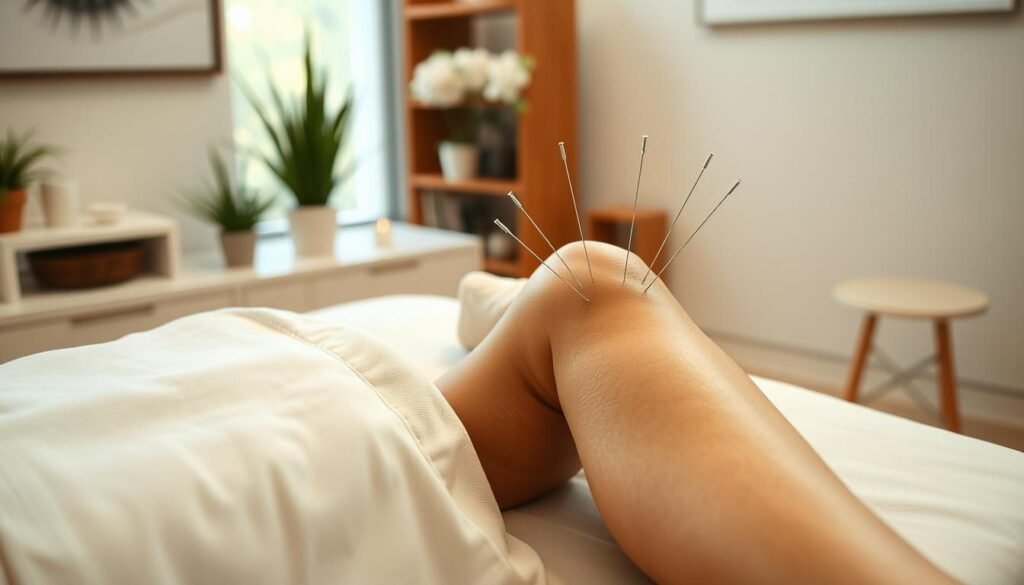
Massage, like Swedish massage, can ease osteoarthritis symptoms. It can reduce pain and stiffness. A study showed people who got a 1-hour Swedish massage weekly saw big improvements12.
Some herbal supplements and nutraceuticals might help with osteoarthritis. Glucosamine and chondroitin are often taken together to support joints. The recommended dose is 500-1,500 milligrams daily12.
But, research on their effectiveness is mixed. Some studies show benefits, while others say they’re no better than a placebo13.
Omega-3 fatty acids, found in fish oil and plants, might also help. They could ease pain and improve function. More research is needed, but adding omega-3-rich foods or supplements might help13.
| Therapy | Potential Benefits | Considerations |
|---|---|---|
| Acupuncture | Pain relief, improved function | May require multiple sessions |
| Massage Therapy | Reduced pain and stiffness | Short-term relief |
| Glucosamine & Chondroitin | Supports joint health | Mixed research results |
| Omega-3 Fatty Acids | Pain relief, improved function | More research needed |
Always talk to a healthcare provider before trying new treatments. While these options might help, they shouldn’t replace medical care for osteoarthritis.
When other treatments don’t work, injections and surgery might be next. These methods can help manage pain and improve joint function. They can also make life better for those with severe osteoarthritis.
Corticosteroid injections are for when other treatments don’t help with pain14. They put anti-inflammatory medicine directly into the joint. This gives quick pain relief and better function for those with osteoarthritis.
Hyaluronic acid injections add a lubricating fluid to the joint. They might offer longer relief than corticosteroids. But, more research is needed to know how well they work for osteoarthritis.
For very bad osteoarthritis, surgery might be needed14. This surgery removes the old joint and puts in new parts. The most common surgeries are for the knee, hip, and shoulder.
About 25% of patients after osteotomy need more surgery in five years15. Most of these are knee replacements. After tibial osteotomy, about a quarter fail after ten years, needing more surgery15.
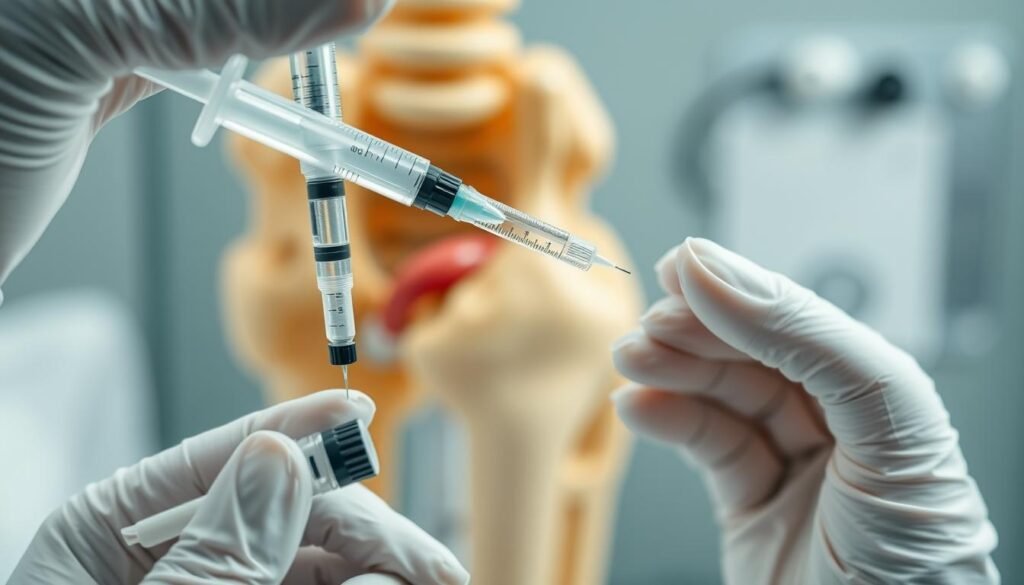
Osteotomy is another surgery for osteoarthritis. It realigns bones to take weight off the damaged joint. It can be done on the knee or hip to ease pain and improve function.
Surgery can really help with severe osteoarthritis. But, talking to a doctor about risks and benefits is key. This helps decide the best option for each person.
| Intervention | Advantages | Disadvantages |
|---|---|---|
| Corticosteroid Injections | Short-term pain relief, improved function | Temporary effects, potential side effects |
| Hyaluronic Acid Injections | Potentially longer-lasting benefits | Uncertain efficacy, requires further research |
| Joint Replacement Surgery | Significant pain relief, improved mobility | Invasive procedure, potential complications |
| Osteotomy | Redistributes weight, alleviates pain | May require subsequent surgeries |
Chronic pain from osteoarthritis can really affect how you feel. People with certain conditions like osteoarthritis and fibromyalgia often feel more pain and sadness. They also have higher rates of depression than others16.
Pain and emotions are closely linked. Those with depression are more likely to have chronic pain. And people with chronic pain are more likely to feel depressed16.

But, there are ways to deal with chronic pain and feel better emotionally. Treating depression and anxiety can also help with physical pain16. Psychosocial interventions, like cognitive behavioral therapy (CBT), can greatly improve pain and emotional health1617.
There are many pain management techniques that can help. Some effective ones include:
These methods help you stay in the moment and reduce stress. They can change how you see pain. CBT is especially good at changing negative thoughts about pain16.
Learning to manage pain yourself is also important. This is especially true for those who don’t respond well to traditional treatments17.
Doing things that reduce stress and help you relax can also improve your emotional state and pain management. Some good activities include:
These activities can help with depression, anxiety, and pain. They can also improve how well you move16. Early training in pain coping skills can lead to better joint health and emotional well-being17.
In patients with osteoarthritis, such training can also improve pain and physical function17.
“The way people interpret and cope with emotions and pain can influence brain patterns.”16
By using pain management, stress reduction, and relaxation in your daily life, you can manage your chronic pain better. This can also improve your emotional well-being.
Eating a balanced diet is key to managing osteoarthritis symptoms. It helps reduce pain and improve joint health. Focus on anti-inflammatory foods and keeping a healthy weight.

An anti-inflammatory diet includes fruits, vegetables, whole grains, lean proteins, and healthy fats. It fights inflammation linked to osteoarthritis. A Mediterranean diet, rich in these foods, may ease symptoms18.
Adding foods like cherries and nuts, which have anti-inflammatory compounds, supports joint health19. Avoid processed sugars and saturated fats, as they can worsen symptoms18. Choose whole grains for their fiber and nutrients that fight inflammation19.
Some nutrients are vital for healthy joints and managing osteoarthritis. Omega-3 fatty acids in fish like salmon are anti-inflammatory20. Eating two portions of fish a week, including oily fish, supports joint health20.
Vitamin D is crucial for bone and cartilage health20. Getting enough vitamin D through sunlight, fortified foods, or supplements keeps bones strong. Antioxidants in colorful fruits and vegetables also protect against osteoarthritis-related oxidative stress20.
| Nutrient | Food Sources | Benefits for Osteoarthritis |
|---|---|---|
| Omega-3 Fatty Acids | Salmon, sardines, chia seeds, flaxseeds | Anti-inflammatory properties, reduces joint pain and stiffness |
| Vitamin D | Sunlight exposure, fortified dairy products, fatty fish | Maintains bone and cartilage health, reduces risk of osteoarthritis progression |
| Vitamin C | Citrus fruits, berries, bell peppers, broccoli | Promotes collagen synthesis, supports joint health |
| Anthocyanins | Cherries, blueberries, blackberries, purple grapes | Possess anti-inflammatory effects, reduce joint pain and inflammation |
Some people think avoiding certain foods helps with osteoarthritis. But there’s no strong evidence for this1820. Focus on a well-rounded diet that meets your needs and preferences.
Keeping a healthy weight is important for osteoarthritis patients. Excess weight can stress joints like knees and hips. Today, 1 in 4 adults in America live with arthritis, and obesity is a major risk factor19.
Losing at least 10% of body weight can greatly improve symptoms. A balanced diet with fiber, lean proteins, and healthy fats supports weight loss and joint health. Foods high in fiber, like beans and whole grains, help manage weight19. But those with celiac disease or gluten sensitivity should be careful about whole grain choices to avoid inflammation19.
By focusing on an anti-inflammatory diet, nutrients for joint health, and a healthy weight, you can manage osteoarthritis symptoms. Consult a healthcare professional or registered dietitian to create a personalized nutrition plan.
Regular exercise is key for those with osteoarthritis to keep joints moving and stay healthy. Studies show that exercise is the best non-drug treatment for osteoarthritis pain and movement21. It helps reduce joint pain and fight off fatigue22.
Low-impact exercises like walking, swimming, and cycling are great for most with osteoarthritis21. They strengthen muscles, improve flexibility, and cut down on pain22. Aquatic exercises in shoulder-height water ease joint pressure and build muscle strength21.
Strengthening exercises build strong muscles that support and protect joints22. Weight training should be done every other day for at least two days a week22. Daily range-of-motion exercises help keep joints flexible21. Tai Chi and Yoga are also good for managing osteoarthritis by strengthening muscles and improving flexibility23.
The weekly goal for aerobic exercise is 150 minutes of moderate or 75 minutes of vigorous activity21. Start slowly and aim for 150 minutes of moderate-to-vigorous exercise per week23. Arthritis patients should aim for about 150 minutes of somewhat hard aerobic exercise weekly22.
| Exercise Type | Frequency | Duration |
|---|---|---|
| Aerobic | 3-5 times per week | 30-60 minutes |
| Strength Training | 2-3 times per week | 20-30 minutes |
| Range-of-Motion | Daily | 5-10 minutes |
Creating a personalized exercise plan with a healthcare team is recommended21. Always consult a healthcare provider to find the right exercises for your condition23. The Arthritis Foundation offers exercise programs across the United States for people with arthritis22.
Different forms of planned motion, such as lifting weights, walking on a treadmill, or taking a yoga class, can help improve or maintain physical fitness and alleviate discomfort caused by arthritis.
Exercise is not the only thing that helps. Losing ten percent of body weight can also reduce knee strain and pain23. Making lifestyle changes like increasing activity and losing weight can greatly help with osteoarthritis23.
Managing osteoarthritis well means using many treatments together. This includes non-medical and medical options, lifestyle changes, and sometimes injections or surgery. Over 50% of people over 65 have osteoarthritis signs24. About 10% of men and 18% of women have symptoms24.
Osteoarthritis affects joints like knees, hips, hands, feet, and spine. Symptoms include pain, stiffness, swelling, and trouble moving25. Knowing about treatments and living healthy can help a lot. This way, people with osteoarthritis can feel less pain and keep their joints healthy.
Exercising regularly helps with pain and movement in hip and knee OA. It’s shown to be effective in the moderate range24. Losing weight by 2kg/m2 over 10 years can lower OA risk by over 50%24. Staying active is key, and so is eating well to manage symptoms.
Working with doctors, physiotherapists, and dietitians is important. They help create a plan that fits your needs25. A team approach can help manage symptoms and improve life quality. It also prevents problems like poor sleep and trouble with daily tasks25.
With the right treatment and support, people with osteoarthritis can live well. Organizations like Arthritis Australia offer help. They help people stay active and enjoy life.
Obesity is the biggest risk factor for osteoarthritis that you can change. Losing 5-10% of your weight can really help. It makes your joints feel better and reduces stress on them.
For osteoarthritis, doctors recommend several key steps. These include land-based exercises, managing your weight, and doing strength training. Water-based exercises, self-management, and education are also important. These steps can lessen pain, improve joint function, and boost your overall health.
Doctors often start with NSAIDs for osteoarthritis. They work as well as or better than acetaminophen. But, NSAIDs can have side effects like stomach problems and heart risks. So, it’s crucial to think about each patient’s situation when choosing a medication.
Some research shows acupuncture can help with knee osteoarthritis pain and function. Massage might also offer quick pain relief. Yet, more studies are needed to confirm these therapies’ long-term benefits.
Corticosteroid injections can give quick pain relief and better function for a short time. They’re good for acute pain, joint swelling, and inflammation. Hyaluronic acid injections might offer longer relief, but their effectiveness is still up for debate.
Dealing with chronic pain from osteoarthritis can affect your mood. Techniques like deep breathing, meditation, and muscle relaxation can help manage pain and stress. Enjoying activities, staying in touch with loved ones, and getting mental health support are also key for emotional health.
Exercise is vital for keeping joints mobile and healthy with osteoarthritis. Low-impact activities like swimming, cycling, and walking are best. They strengthen muscles, improve flexibility, and reduce pain. Always listen to your body and avoid activities that hurt. A physical therapist or doctor can help create a safe exercise plan for you.